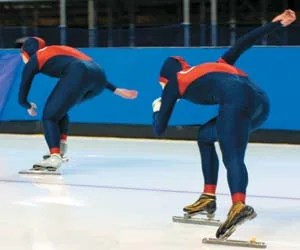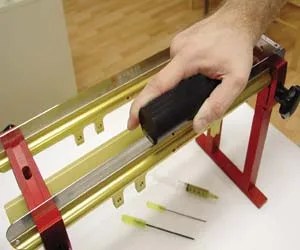3 min read
Of all the benefits NASA technology gives the world, the ability to skate faster probably isn't one that most people might have thought about. Neither did the gold medal winner, at first.
In February 1998, the U.S. Speedskating team came home from the Winter Olympic Games in Nagano, Japan, with a silver and bronze medal.

Image Right: The U.S. Speedskating organization looked to NASA for new ways to enhance skate technology. Three weeks prior to the Salt Lake City Olympics the new technique was tested with winning results. Credit: NASA
Looking forward to the 2002 Olympics in Salt Lake City, the team was determined "to go for the gold." But its members knew they needed help to make their dreams of winning first place come true.
"If NASA can put a man on the moon, surely they can help our skaters" said Finn Halvorsen U.S. Speedskating Director.
In an effort to help the skaters through NASA technology, Darryl Mitchell of Goddard Space Flight Center's Technology Commercialization Office in Maryland met with the U.S. Olympic Committee in 1999.
After a crash course in speedskating, Mitchell was able to make suggestions that could benefit the skaters. He found a polishing method that came from the refining of NASA's Hubble Space Telescope mirrors.
Since Hubble's mirrors had to be ground and polished to achieve sharp, clear images in space, why not use some of that polishing technology on the skate blades to decrease the friction and improve glide?
Although that exact process didn't work as well on the skates as the team had hoped, another method was developed from the original NASA process that worked like a charm.

The new polishing process and tool, invented by a former NASA Goddard Space Flight Center optical engineer, did the trick.
Image Left: The new polishing process is an extension of how speedskaters typically sharpen their blades after the use of a sharpening stone and other sharpening tools. Credit: NASA
Speedskater Chris Witty, the winner of the only two U.S. medals in Nagano, decided to take a chance and use the new polishing technique on her skates.
Amazed at the difference it made in her speed, Witty used the newly-polished blades to speed past all the other competitors, victorious in the 1,000 meter race.
Witty set a new world record and earned a gleaming gold medal. Other American speedskaters, using the new polishing method, also sped to victory.
Although
sees mankind traveling throughout the universe, the Agency's technology is giving us the "edge" right here on Earth.
For further information, visit:
Elaine M. Marconi
NASA's John F. Kennedy Space Center
Courtesy of the Innovative Technology Transfer Partnerships Program







